Magnetic Recording Technology
 Using magnetic fields to store data is a fundamental part of computer and media technology. 1.) How it Works
|
1.) How it Works:
The basic concept of magnetic recording is simple, you energize an electromagnet
so it effects the recording medium. The medium is made of a magnetic
material like iron oxide or iron-cobalt and it
polarizes the metallic grains in one direction or the other (this can
be up or down or side to side).
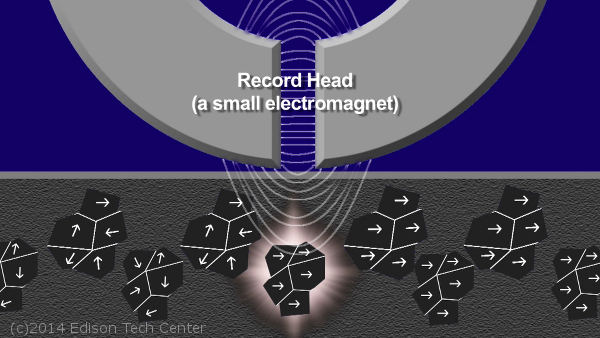
The magnetic medium is engineered from special combinations of materials so that it can easily 'pick up' the polarity given by the 'write head', but does not easily lose the polarity after the fact. All magnetic material eventually migrates back to a chaotic formation as other magnetic fields in close proximity (like layers of tape on top of each other) affect each other. A tape or hard disk made of a good material will hold data for many years and can be read later on.
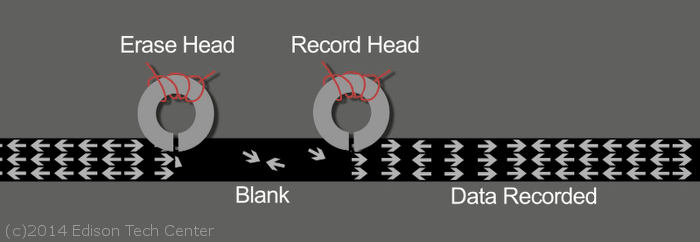
Above: simplified model of a compact cassette tape.
Engineers at companies like 3M, Ampex, and BASF worked for many years researching many kinds of magnetic materials deposited on plastic and metal substrates. The basics of understanding magnetic recording involve chemistry and mechanical engineering.
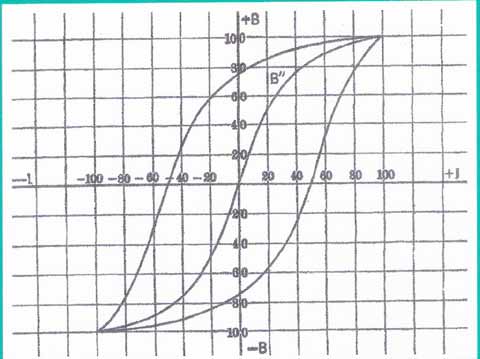 Above: The hysteresis loop |
|
Since Charles P. Steinmetz figured out the mathematics of magnetism in materials engineers have been using the hysteresis loop to design recording technologies. Each material has a different loop. A wider loop means more energy is required to flip the polarity of the material. Engineers use a bias signal to help obtain a predictable and high level of magnetization. See the link below to learn more details.
About the Hysteresis Loop in magnetic recording here >
2.) Video, Audio and Data Recording:
Below - Dr. Thomas Carroll talking about iron oxide strips, and video/audio tape recording in the first 45 seconds of this video.
3.) Major Types/Formats of Recorders:
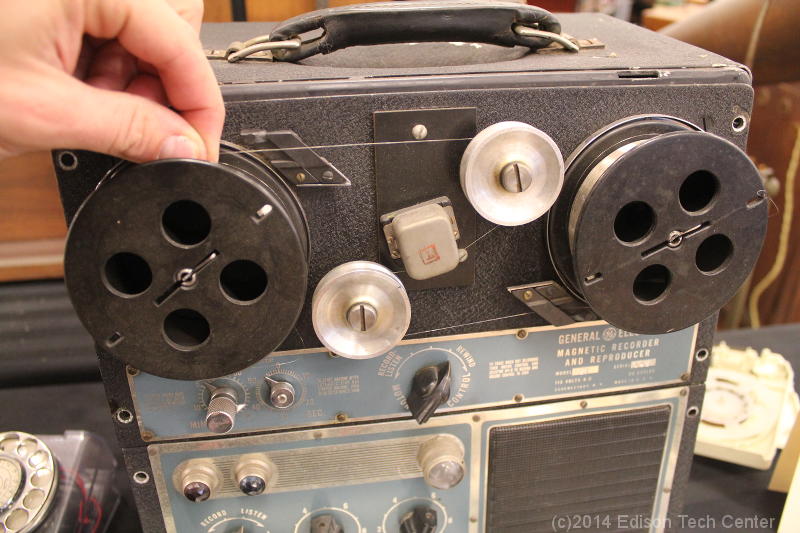
Wire Recorders - The 1940s-50s were the golden age of wire recorders, they were a bulky consumer audio recorder. The recorder had been first devised around 1900 as an alternative to wax cylinder recorders. The idea was to record onto a steel wire. During the late 40s and early 50s engineers developed much higher quality recording with wire, however it was to be replaced by hi-fi (high-fidelity) tapes.
Magnetic Strips - You can find these on credit and ID cards. This
is basically like a magnetic tape except that it is short and contains
repeating alphanumeric codes. Swipe the card in a MSR (magnetic strip
reader) and it should pick up the code even if parts of the recording
have been damaged by other magnetic fields. Some magnetic strips can be
erased by placing a mobile phone in the same pocket. Other magnetic strip
technologies use materials which are not easily effected by other magnetic
fields.
Tape Recorders:
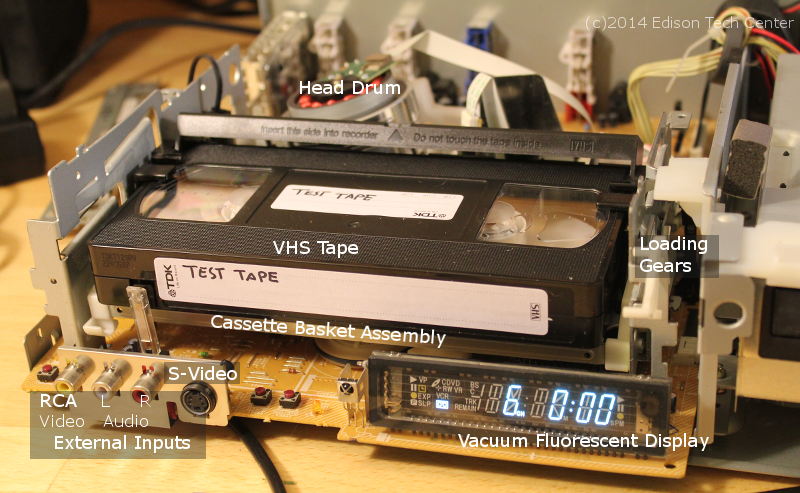
There are many kinds of tape recording, from open reels which need to
be strung into a machine by hand, to a myriad of cassette tape formats
and sizes.
The Edison Tech Center has many historic types of tape on display which
you can touch and examine such as:
8 Track (consumer audio)
Compact Cassette Tape (consumer audio)
VHS (consumer video)
Beta (consumer and professional video)
Quasar VX (consumer video)
3/4" tape (professional video)
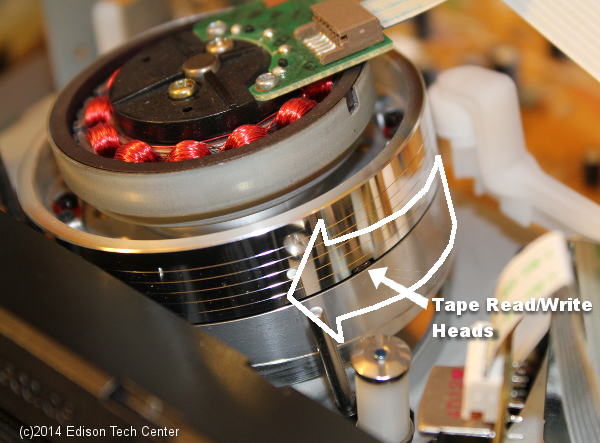 |
Left: VHS tape head drum. The head assembly spins at 1800 rpm (NTSC) while the 1/2" tape is wrapped around it (hollow white arrow). One half rotation is equal to one TV field. The head records thin diagonal tracks across the tape. Tracks are 20+ microns wide, the width depends on whether you are in LP or SP mode. |
4.) Data Recording:
In 1951 the UNIVAC computer became the first computer to use magnetic data storage. It used 1/2" wide nickel-plated bronze tapes. Magnetic recording became a keystone of computer operation as it replaced the more cumbersome, slower punched card readers. Solid state drives continue to grow and replace many magnetic storage methods however magnetic storage remains the most cost effective way to store large amounts of data. Magnetic tape storage remains the main method of long term data storage.
Hard Disk Drives:
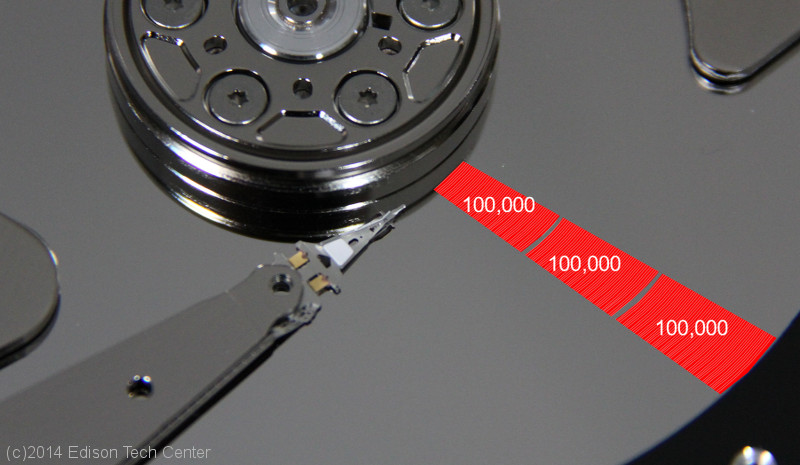
Above: 300,000 magnetic tracks are recorded on a standard 3.5" drive.
Learn more about HDDs on our site here >
See our video below with Seagate engineer J. Larson on how
HDDs work:
Data Tapes:
The large tape reel computers of the 50s and 60s have been replaced by
machines a fraction of the size, however tapes are still in use as long
term backup and are not going away. Today companies like Spectra use tapes
for deep long term storage for individuals, corporations and even the
government. Consumers can buy their own tape drives and back up their
own material.
Cassettes have a long future, in 2012 cassettes from IBM and Fujifilm
could store up to 35 Terabytes, and that number continues to go up. Tapes
are in competition with 3D optical media, however three dimensional optical
media has yet to prove itself against the longevity of tape. In the field
of critical long term storage new technology must prove itself and is
adopted slowly.
History of Magnetic Recording:
Here is a great article on the history
from the Audio Engineering Society >
Related Topics:
|
Iron and Electrical Steel |
Electric Motors |
Hard Disk Drives |
Loudspeakers |
Television |
More Stuff |
Article by MW and W.Kornrumpf
Sources:
Audio Engineering Society
Interview with Historian Thomas Carroll, Edison Tech Center. 2013
Media Source Online
SSD Market History by Zsolt Kerekes
Recording-history.org
Swinburne University
Georgia State University
Photos:
Edison Tech Center / Minerals Education Coalition

